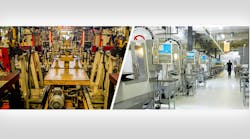Since reaching a high-water mark in March 2015, the U.S. has lost 68,000 durable manufacturing jobs, including losses in machinery (46,000), fabricated metal products (36,000) and primary metals (22,000). Manufacturing lost 29,000 jobs in March 2016 alone, according to the U.S. Bureau of Labor Statistics. These numbers are felt deeply throughout traditional manufacturing hubs across the country. They touch families and communities – many of which are built around these jobs.
At the same time, American employers cannot find the talent they need to run modern shop floors – a challenge that’s only growing as output of American manufacturing continues to accelerate. According to a recent Deloitte study, by 2020 America will be the most competitive manufacturing economy in the world, surpassing China.
Therein lies a paradox: While America is shedding manufacturing jobs, American manufactures cannot find the workforce needed to keep up with the growing demand for their services.
One of the driving forces behind all this is the transition to digital manufacturing. This digitization of manufacturing processes is breathing new life into traditional manufacturing companies and increasing the productivity of employees in their labor force. Because of advances in digital manufacturing, America is producing everything from shoe soles to drone propeller blades more efficiently and affordably.
Most acute is a shift in the skill requirements of our labor force. The increased use of robotics and the automation in manufacturing demand higher-skilled employees who are able to write and manage the software and hardware that control manufacturing equipment. There is greater demand for researchers who can push innovation and productivity even further. And software developers who can weave automation into assembly lines, production cost estimates and product design are a precious and rare resource in digital manufacturing.
To grow the next manufacturing labor force, the industry needs to focus on three areas of improvement. We need to:
- Debunk myths about manufacturing jobs.
- Get the word out about high-paying jobs.
- Improve job readiness.
Debunk Myths About Manufacturing Jobs
To stimulate a new fascination with the industry and attract workers with those skills needed to manage modern shop floors, we need to debunk long-held myths about manufacturing jobs. Perceptions of dirty, smoky work environments are not the reality of the digital-manufacturing industry. Modern manufacturing floors are as easy to picture in a Silicon Valley-based office park as they are in a rural Midwestern town.
There’s a sense of purpose among the software developers, production techs and product designers who collaborate in airy, new office spaces. They feel inspired that they provide the digital thread that enables 3D CAD files to be sent to an injection molding, CNC machining or 3D printing machine – all with the click of a mouse. They’re invigorated by the idea of helping companies produce tomorrow’s next big thing.
Get the Word Out About High-Paying Jobs
With increased skills comes higher pay, so it’s not surprising that digital manufacturing is shifting the pay curve for manufacturing employees in the U.S.
Mold techs are a good example of this in practice. Before every production run on an injection-molding press, a highly skilled mold tech has to prep and tune the press. This front-end work is custom to every job and is part art, part science. Because digital manufacturers provide their customers with options for shorter production runs – for example, 100 runs of 1,000 parts rather than a single run of 1 million parts – they need 10 times more mold techs than traditional manufacturers do. This is driving up demand for these highly skilled workers, and today an entry-level mold tech can expect to make as much as $70,000 per year right out of school.
Mold techs are just one example of high-paying jobs that digital manufacturing is creating. As an industry, we need to be better at informing job seekers about the opportunities in these high-potential career paths.
Improve Job Readiness
Developing America’s next-generation workforce starts with expanding and accelerating STEM education. We need more computer and materials engineers. We also need a bigger bench of highly skilled trade workers like the mold techs mentioned above.
The industry needs to work directly with high schools, trade colleges and universities to enhance vocational training programs. Greater curricular emphasis is needed in data analysis, CAD and analytics, because data is the “oil” powering digital manufacturing. Furthermore, we need to be more explicit with educators about the skills we want in our new hires.
We also need to think about all those traditional manufacturing jobs being lost and determine how to re-engage and re-train those workers so they can be even more productive in the digital-manufacturing environment.
To that end, manufactures play an important role by expanding their new-employee onboarding and training programs. For example, Proto Labs, which has been growing 20% to 25% per year, launched Proto Labs University to boost new employees’ skills and to position them to drive the company’s continued growth. The robust training program also helps new hires understand the nuances of our company’s unique culture and expectations.
Manufacturing has advanced rapidly, and the software developers writing the code and the production techs on the shop floor need to advance just as fast. According to Deloitte’s recent analysis of the manufacturing space, the top driver of manufacturing competiveness is talent. If America wants to dominate manufacturing in the 21st century as it did for most of the 20th, the industry must work to change the perception of manufacturing jobs; re-examine how we incentivize highly skilled employees; and evolve how we onboard and nurture the next generation of manufacturing talent.
Victoria M. Holt has been president and CEO of Proto Labs since February 2014. She served as president and CEO of Spartech Corp., a leading producer of plastic sheet, compounds and packaging products, from September 2010 until Spartech was purchased by PolyOne Corp. in March 2013. Prior to Spartech, Holt worked at PPG Industries.





